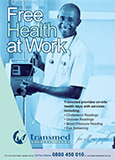Diabetes Insipidus
What is diabetes insipidus?
Diabetes insipidus is a condition characterised by the excretion of large amounts of severely diluted urine, increased fluid intake and thirst.
Causes of diabetes insipidus
There are two causes of diabetes insipidus:
- In some patients, a part of the brain (called the hypothalamus) doesn't make enough of the antidiuretic hormone (ADH), which helps your body balance water in the urine and blood. In other patients, the kidneys don't work with this hormone in the way they should. Most people with diabetes insipidus get it after an injury to the head or after brain surgery.
- Diabetes insipidus may be hereditary; or some medication, like lithium, can also cause it. In about 25% of cases, doctors can't identify the cause.
How do you test for diabetes insipidus?
Usually your doctor will check your urine to see how much water and soluble substances it contains. Your doctor may also check your blood and give you a ‘water deprivation' test. During this test, you aren't allowed to drink any liquids. Medical staff will weigh you, and check your urine and blood every hour for several hours. If the results of the test show that you have diabetes insipidus, you may have pictures taken of your brain with a computed tomography (CT) scan or a magnetic resonance image (MRI) scan to identify any problems.
Treatment of diabetes insipidus
If the symptoms don't adversely affect you, you need not take any action. However, your doctor may want to check up on you more often. You should ensure that you always have something to drink, to avoid getting dehydrated.
If you need to get up often at night to urinate, you may consider taking desmopressin (DDAVP), a medication which treats this problem. This acts as your body's natural ADH. This medication is available as a nasal spray but also in other forms. If you take DDAVP, you shouldn't drink too much, as your body may become ‘overloaded' with fluid, which may cause you to feel sick, weak or dizzy.
If your diabetes insipidus is caused by your kidneys not working well with the ADH, then DDAVP won't help. Other medication, like hydrochlorothiazide (a 'water' pill), may help in this case. Water pills help your body balance salt and water.
Discuss these options with your doctor to find out which one would work best for you.
References
1. Algorithms of Council of Medical Schemes. 6 October 2003. Government Gazette No 1397.
2. COOPERMAN, Michael. MD: Clinical Associate Professor of Endocrinology, Temple University. Chairman: Department of Internal Medicine, Division of Endocrinology, Jeanes Hospital.
3. COOPERMAN, Michael. November 2003. Emedicine: Diabetes Insipidus.
4. DE KLERK, Manie (Prof.). Qualsa Guideline. November 2004.
5. http://www.arupconsult.com/Algorithms/CentralDiabetesInsipidus.pdf
6. http://www.emedicine.com/med/topic543.htm
7. http://www.lhsc.on.ca/icu/orders/di.pdf
8. http://www.medicalschemes.co.za/Publications/Diabetes.pdf
9. Merck Manual of Diagnosis and Therapy.17th Edition.Section 17,Chapter 229.
10. Merck Manual of Diagnosis and Therapy.17th Edition.Section 2,Chapter 7.
11. www.merck.com/pubs/mmanual/section17/chapter229/229c.htm
12. www.merck.com/pubs/mmanual/section2/chapter7/7c.htm
 TransmedBanner4.jpg)

